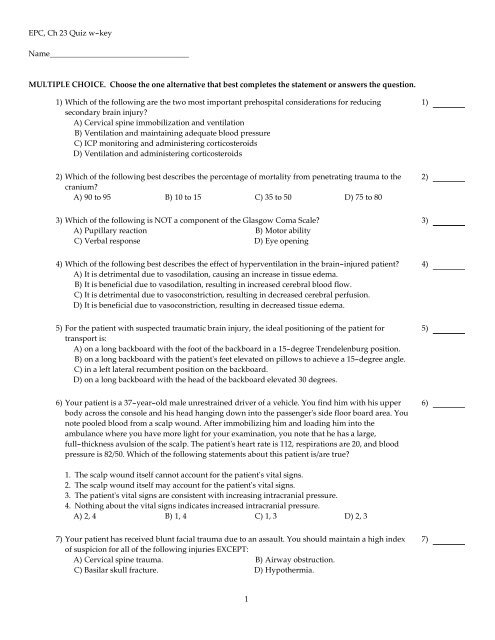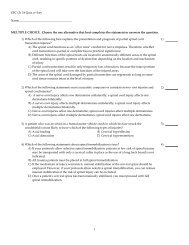EPC, Ch 23 Quiz w-key ...
EPC, Ch 23 Quiz w-key ...
EPC, Ch 23 Quiz w-key ...
You also want an ePaper? Increase the reach of your titles
YUMPU automatically turns print PDFs into web optimized ePapers that Google loves.
<strong>EPC</strong>, <strong>Ch</strong> <strong>23</strong> <strong>Quiz</strong> w-<strong>key</strong>Name___________________________________MULTIPLE CHOICE. <strong>Ch</strong>oose the one alternative that best completes the statement or answers the question.1) Which of the following are the two most important prehospital considerations for reducingsecondary brain injury?A) Cervical spine immobilization and ventilationB) Ventilation and maintaining adequate blood pressureC) ICP monitoring and administering corticosteroidsD) Ventilation and administering corticosteroids1)2) Which of the following best describes the percentage of mortality from penetrating trauma to thecranium?A) 90 to 95 B) 10 to 15 C) 35 to 50 D) 75 to 802)3) Which of the following is NOT a component of the Glasgow Coma Scale?A) Pupillary reaction B) Motor abilityC) Verbal response D) Eye opening3)4) Which of the following best describes the effect of hyperventilation in the brain-injured patient?A) It is detrimental due to vasodilation, causing an increase in tissue edema.B) It is beneficial due to vasodilation, resulting in increased cerebral blood flow.C) It is detrimental due to vasoconstriction, resulting in decreased cerebral perfusion.D) It is beneficial due to vasoconstriction, resulting in decreased tissue edema.4)5) For the patient with suspected traumatic brain injury, the ideal positioning of the patient fortransport is:A) on a long backboard with the foot of the backboard in a 15-degree Trendelenburg position.B) on a long backboard with the patient's feet elevated on pillows to achieve a 15-degree angle.C) in a left lateral recumbent position on the backboard.D) on a long backboard with the head of the backboard elevated 30 degrees.5)6) Your patient is a 37-year-old male unrestrained driver of a vehicle. You find him with his upperbody across the console and his head hanging down into the passenger's side floor board area. Younote pooled blood from a scalp wound. After immobilizing him and loading him into theambulance where you have more light for your examination, you note that he has a large,full-thickness avulsion of the scalp. The patient's heart rate is 112, respirations are 20, and bloodpressure is 82/50. Which of the following statements about this patient is/are true?6)1. The scalp wound itself cannot account for the patient's vital signs.2. The scalp wound itself may account for the patient's vital signs.3. The patient's vital signs are consistent with increasing intracranial pressure.4. Nothing about the vital signs indicates increased intracranial pressure.A) 2, 4 B) 1, 4 C) 1, 3 D) 2, 37) Your patient has received blunt facial trauma due to an assault. You should maintain a high indexof suspicion for all of the following injuries EXCEPT:A) Cervical spine trauma. B) Airway obstruction.C) Basilar skull fracture. D) Hypothermia.7)1
8) A growing lesion in the right cranial hemisphere will most likely result in which of the following?A) Normal left pupil; dilated, nonreactive right pupilB) Bilaterally constricted, nonreactive pupilsC) Normal right pupil; dilated, nonreactive left pupilD) Bilateral midpoint, nonreactive pupils8)9) Your patient is a 45-year-old male with extensive blunt trauma to the face. He has decorticateposturing in response to pain; weak, irregular respiratory effort at 6 per minute; and a heart rate of50 with a good radial pulse. The patient appears to have nasal and mandibular fractures, and anoropharyngeal airway is insufficient to keep the tongue from the posterior pharynx. Which of thefollowing has the MOST potential to negatively impact the patient?A) Oral intubation under direct laryngoscopyB) Nasotracheal intubationC) Retrograde intubationD) A nonvisualized dual lumen airway9)10) A closed head injury may present with a set of signs known as Cushing's triad. All of the followingare part of Cushing's triad EXCEPT:A) Slowing pulse. B) Increasing respirations.C) Erratic respirations. D) Increasing blood pressure.10)11) Your patient is a 22-year-old female assault victim. She has blunt trauma to the face with swellingaround the right eye and zygomatic area. Upon assessing her eye movement, you note that theright eye cannot follow your finger and does not move. Which of the following most likely explainsthis finding?A) She has a fracture of the orbit that has trapped the optic nerve, thereby paralyzing her gaze.B) She has direct trauma to the eyeball that has damaged the intrinsic muscles of the eye.C) She has direct trauma to the eyeball that has damaged the optic nerve, thereby paralyzing hergaze.D) She has a fracture of the orbit that has trapped the extrinsic eye muscles.11)12) Which of the following parameters should be used to guide the oxygenation and ventilation of thepatient with a traumatic brain injury?A) Maintain an oxygen saturation level > 95% and a capnography reading < 35%.B) Maintain an oxygen saturation level > 90% and a capnography level < 45 mmHg.C) Maintain an oxygen saturation > 95% and a capnography reading between 35 and 45 mmHg.D) Maintain an oxygen saturation level > 95% and a capnography reading > 45 mmHg.12)13) Central herniation syndrome typically results in which of the following?A) Retrograde amnesia B) Anterograde amnesiaC) Central neurologic hyperventilation D) <strong>Ch</strong>eyne-Stokes respirations13)14) Which of the following medications may be indicated in the prehospital management of the patientwith traumatic brain injury?A) Furosemide B) MethylprednisoloneC) Mannitol D) Diazoxide14)15) You are caring for a 22-year-old amateur boxer who complained of a sudden obstruction of part ofhis visual field. This complaint is most consistent with which of the following conditions?A) Retinal detachment B) Subconjunctival hemorrhageC) Hyphema D) Extrusion of the eyeball15)2
16) Which of the following mechanisms causes indirect brain injury?A) Acceleration/deceleration forces without a direct blow to the craniumB) Coup/contrecoup injuriesC) Cushing's reflexD) Systemic hypotension combined with increasing intracranial pressure16)17) The term head injury refers to which of the following?A) Skull fractures B) Trauma to the brainC) Soft tissue injuries to the scalp D) All of the above17)18) Which of the following skull fractures are most common?A) Communited B) Linear C) Depressed D) Basilar18)19) Which of the following may result from seizure, worsening the condition of the patient with atraumatic brain injury?A) Increased intracranial pressure due to the seizure activityB) Increased cerebral edema due to impaired ventilationC) Exacerbation of existing brain injury due to physical agitationD) All of the above19)20) A concussion is best described as which of the following types of brain injuries?A) Direct, focal B) Indirect, diffuse C) Indirect, focal D) Direct, diffuse20)3
Answer KeyTestname: <strong>EPC</strong>, CH <strong>23</strong> QUIZ W-KEY1) BDiff: 2 Page Ref: 970Objective: 462) DDiff: 1 Page Ref: 959Objective: 353) ADiff: 1 Page Ref: 972Objective: 434) CDiff: 2 Page Ref: 992Objective: 415) DDiff: 2 Page Ref: 986Objective: 466) ADiff: 3 Page Ref: 961Objective: 437) DDiff: 2 Page Ref: 972Objective: 378) ADiff: 2 Page Ref: 972Objective: 399) BDiff: 3 Page Ref: 987Objective: 910) BDiff: 2 Page Ref: 971Objective: 4311) DDiff: 2 Page Ref: 973Objective: 612) CDiff: 2 Page Ref: 990Objective: 4713) DDiff: 2 Page Ref: 971Objective: 3914) ADiff: 2 Page Ref: 992Objective: 4315) ADiff: 2 Page Ref: 976Objective: 1316) DDiff: 2 Page Ref: 968Objective: 3717) DDiff: 2 Page Ref: 961Objective: 3818) BDiff: 1 Page Ref: 962Objective: 5119) DDiff: 2 Page Ref: 981Objective: 3920) DDiff: 2 Page Ref: 968Objective: 394
<strong>EPC</strong>, <strong>Ch</strong> <strong>23</strong> <strong>Quiz</strong> w-<strong>key</strong>Name___________________________________1)2)3)4)5)6)7)8)9)10)11)12)13)14)15)16)17)18)19)20)5



